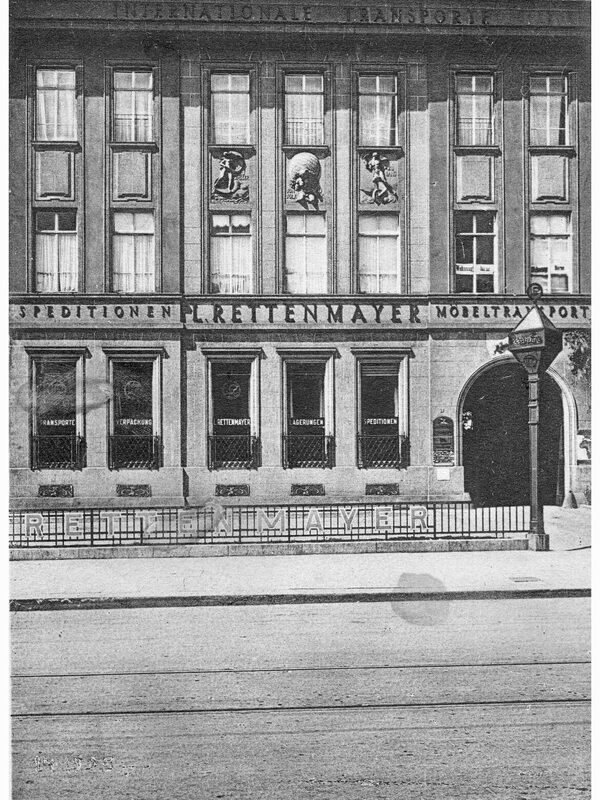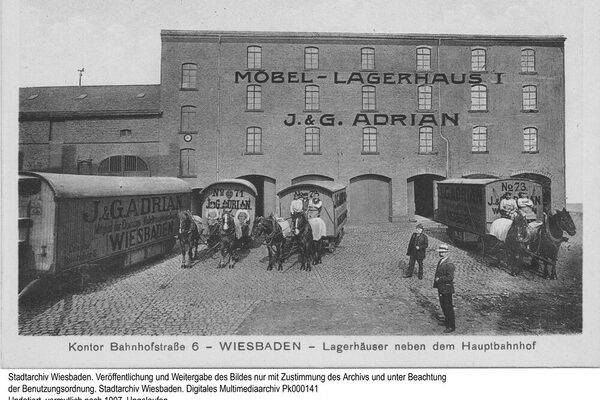Forwarding companies
In 1842, the confectioner, innkeeper and farmer Johann Rettenmayer, who had moved from Hachenburg to Wiesbaden in the 1830s, carried out commercial transportation with a horse-drawn cart for the first time.
The company became a transport company with international business connections in 1869 under Carl Haagner, who was responsible for a significant innovation, namely the construction of special furniture vans for overseas transportation, which could be shipped together with their contents thanks to their small and easily removable wheels. These containers, patented as "furniture boxes without reloading" and later used internationally as "lift vans", revolutionized the transport industry. In 1886, Carl Haagner was appointed the first chairman of the International Furniture Transportation Association. His son Friedrich improved the packing methods, for example by padding the containers, which were now available in all possible sizes. At the end of the 19th century, the forwarding company was awarded the title of "Court Forwarder to the Emperor and King" and "Grand Princely Russian Court Forwarder". The company headquarters in Nicolasstraße (now Bahnhofsstraße) could no longer cope with the company's expansion; in 1904, one of the largest and most modern warehouses in Germany, the "Wiesbadener Möbelheim", was built in Waldstraße. A company health insurance fund was set up for the workers, and the carters were given their own work and wage regulations. The company continued to expand until the outbreak of the Second World War.
In addition to numerous international branches, the "Rhein- und Seeschiffahrts-Gesellschaft Köln und Mannheim" and the Intern. Reise-Bureau in Wiesbaden were founded. The "Möbeltransportgesellschaft Rettenmayer", founded in 1988, is involved in numerous moving companies throughout Europe, renamed itself "TEAM Relocations GmbH" in 2010 and now has 34 branches in twelve countries. The company J. & G. Adrian, founded in 1864, is just as rich in tradition. As the transporter of the court's luggage and silver, Adolph Jacobi, the subsequent company owner, was appointed "His Majesty's Court Forwarding Agent" in 1914. The company survived the First World War just as unscathed as the economic crisis of the 1920s. During the Second World War, the freight forwarding company's buildings in Gartenfeldstraße were destroyed and the vehicles confiscated. The company recovered with the reconstruction after the end of the war and expanded at its new headquarters on Mainzer Strasse.
At the end of the 19th century, Christian Frankenbach founded his haulage company with a team of horses in Mainz-Kastel. His son Ernst expanded the company, which soon had ten carriages, in 1936 to include the first trucks. In the 1950s, the first silo vehicles were purchased, opening up a new business segment. The founder's grandsons joined the company in 1970, marking the start of the family business's global orientation.
In 1904, the "Roll-Comptoir der vereinigten Spediteure GmbH" began operations as an official rail forwarding company in Wiesbaden. In a contract with the Royal Prussian State Railway, the previously unorganized transport of goods of all kinds to and from the Wiesbaden railroad stations was regulated at fixed rates. Over the decades, the company modernized not only its fleet of vehicles but also its fields of activity and its name. The "Speditionsgesellschaft Rollkontor" organizes global transport logistics, its own customs agency and warehouse logistics as well as various archiving and document management systems at its headquarters at Wiesbaden Central Station.
In addition to the nationally and internationally active logistics companies, the "Kraftverkehr Genossenschaft Wiesbaden" played an important role. It was founded in 1928 when nine Wiesbaden hauliers joined forces in the cooperative to centrally organize the placement of transport orders. Initially, their horse-drawn carts supplied the Wiesbaden hotels with water from local springs, among other things. Later, the horse-drawn carriages were replaced by trucks. In the 1960s and 1970s, the number of members and vehicles used increased - at times there were over 60 trucks. With the help of modern vehicles ranging from 7.5- to 42-ton trucks and a solid, regional customer base, the Kraftverkehr Genossenschaft is trying to remain competitive in the future. The established Wiesbaden transport and forwarding companies are complemented by the waste disposal company Knettenbrech and Gurdulic, which was founded in 1950. In 1961, the transport company entered the waste disposal business and over the years developed into one of the leading companies in this sector in the Rhine-Main region.
Literature
Spiegel, Margit: Wiesbadener Firmenbriefköpfe aus der Kaiserzeit 1871-1914. Fabrik- und Hotelansichten auf Geschäftsschreiben und Rechnungen. 50 examples with brief company portraits, vol. 1, Wiesbaden 2003 [pp. 134-136].
Newspaper clippings collection Stadtarchiv Wiesbaden, "Speditions".

